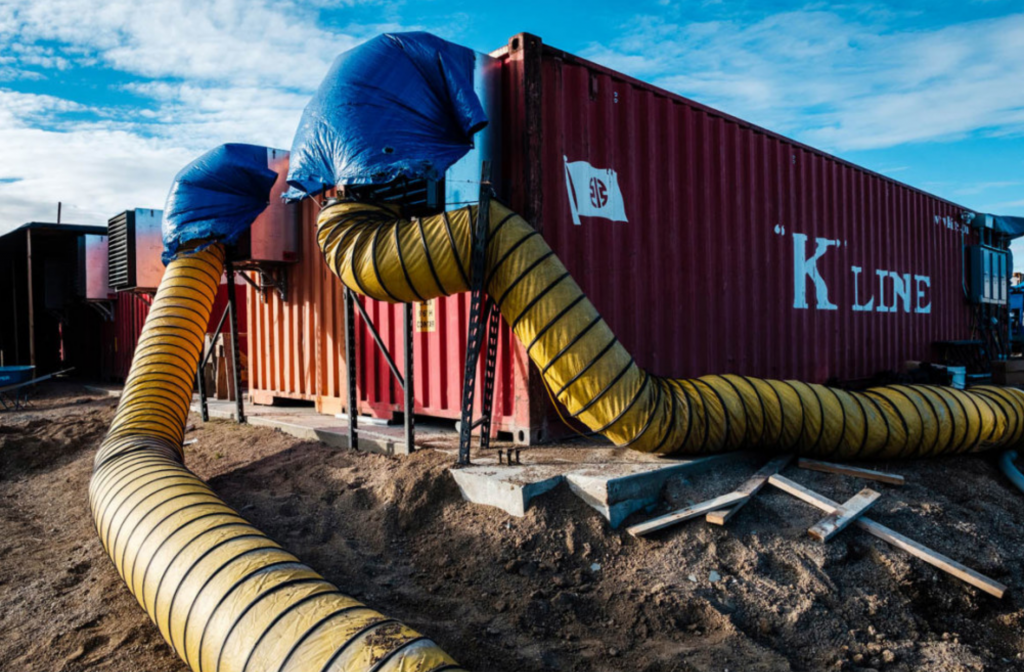
Digital Gold Rush Draws Investors Staking Claims in Eastern Washington
In an article featured in the March/April edition of Politico, journalist Paul Roberts traveled to rural Washington state near the banks of the Columbia River, where for a half a decade investors and crypto cowboys from around the world have taken advantage of the region’s cool temperatures and immense hydroelectric energy surplus to create a cutthroat boomtown economy based on “mining” Bitcoin and other cryptocurrencies.
The computationally-intensive process of mining cryptocurrencies—which involves processing network transactions and minting new units of currency as a reward—requires staggering amounts of processing capability and the tremendous loads of electrical energy required to power and cool mining centers. While mining Bitcoin in the cryptocurrency’s early years was cheap and profitable enough that casual users and early investors could run a viable mining operation on their home PCs, Bitcoin and its myriad other crypto lookalikes feature predetermined difficulty adjustments and periodic reward halvings so that the cryptocurrency can maintain scarcity and match the progress of processor technology.
As a consequence of the bitcoin’s infamous price fluctuations and the network’s increasing difficulty and lessening of bitcoin issuance, Bitcoin mining now requires truly industrial scales of computing equipment and electrical energy, and what was once the domain of crypto nerds running mining rigs in their spare rooms or on gaming PCs has given way to a global cryptocurrency “Wild West” where millionaires and billionaires bearing suitcases of cash have flocked to the world’s cheapest energy centers, especially near hydroelectric centers in China⎯and now Washington state.
Enter the Mid-Columbia Basin, a “semi-arid agricultural region” spanning three counties a few hours east of Seattle which has become one of the best places to mine bitcoin in America—and maybe the world.” Roberts’ article chronicles the rise of the region’s Bitcoin boom, from the initial wave of investors who settled the quiet region most famous for its apple orchards in 2012, to today’s arrivals, large-scale “investors from Wall Street, Europe and Asia” who are raking in cash.
Above: Former Microsoft developer David Carlson was one of the basin’s first major investors, at one point running a mine so vast that it processed a quarter of the entire Bitcoin network’s transactions. Here, he demonstrates one of his tailor-made ‘Giga Pod’ Bitcoin mines.
At the beginning, investors moved into small towns such as Wenatchee, WA looking for viable spaces to establish small-scale mines, buying out vacant properties and local businesses from carwashes and auto shops (favored for their robust electrical systems) to vacant fruit warehouses. Now, a sprawling crypto mining economy has taken over the basin, with everyone from hard-pressed locals to international firms utilizing every available space and watt of electrical power available, cutting lucrative deals for power and building permits with local authorities to continue growing the region’s mining capacity. By some estimates Roberts cites, the Mid-Columbia Basin could process 15 to 30 percent of all bitcoin mining in the world by the end of this year.
The craze has drawn so much interest that “utility crews now actively hunt unpermitted miners, in the same way police look for indoor cannabis farms” and a recent tour of Asian investors “flew their private jet into the local airport, took a rental car to one of the local dams, and, according to a utility official, politely informed staff at the dam visitors center, ‘We want to see the dam master because we want to buy some electricity.’ ” Wealthy people and institutions are investing fortunes to mine Bitcoin in Washington, and in light of 2017’s crypto explosion, are making even larger fortunes in the process. According to Roberts:
by December [2017], a hypothetical investor who had built a 5-megawatt mine in the basin just four months earlier would’ve recovered the $7 million investment and would now be clearing $140,000 in profit every 24 hours.
While most of the basin’s growing cryptocurrency economy is presently based on crypto mining, some residents and investors seek to turn the region into a global hub for the nascent blockchain and crypto industries, attracting the space’s brightest minds— and deepest wallets— away from increasingly exclusive and stratified technology hubs such as Silicon Valley.
Zug, Switzerland, according to the Financial Times, is one such location that’s become one of the crypto environment’s rising capitols. Famous for local adoption of bitcoin for day-to-day transactions and some government fees, crypto and blockchain investment in Zug has garnered the surrounding area the moniker “Crypto Valley.” Zug helped establish Switzerland as the second most profitable market for ICO investment in 2017 behind the USA, and the city is also home to the Ethereum Foundation, the nonprofit established in 2014 by Ethereum developer Vitalik Buterin to oversee the open-source platform’s development.
For the rest of the story on the Mid-Columbia Basin, including commentary by locals on all sides of the growing debate on how basin communities should proceed after the influx of crypto, read the full story at Politico.







Leave A Comment